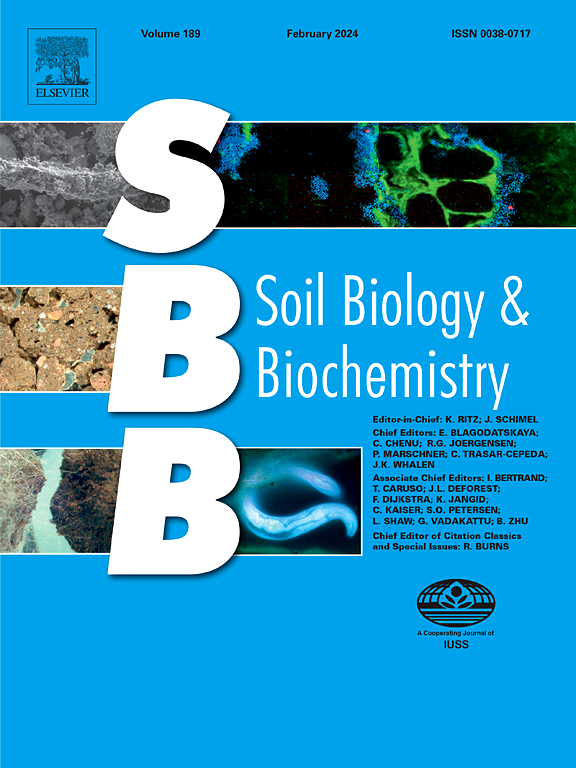Phosphorus-transforming microbes enhance phosphatase catalytic efficiency to alleviate phosphorus limitation under nitrogen and phosphorus additions in subtropical forest soil
IF 10.3
1区 农林科学
Q1 SOIL SCIENCE
引用次数: 0
Abstract
Phosphatase catalytic efficiency (Vmax/Km) is a key determinant of soil phosphorus (P) availability and is governed by microbial P-transformations. In subtropical forest soils, low intrinsic P availability is constrained by atmospheric nitrogen (N) deposition, yet the effects of P-transforming microorganisms and microbial food webs on Vmax/Km remain unclear. This study quantifies how P-transforming microorganisms and microbial trophic interactions modulate phosphatase catalytic efficiency under N, P, and NP additions in subtropical Chinese fir plantations. Partial least squares path modelling revealed two dominant microbial pathways contributing to increased Vmax/Km: (i) N-induced acidification upregulated phosphate transporter genes (e.g., pstB), increasing microbial P uptake; P and NP additions alleviated microbial P limitation and downregulated P-starvation response genes (e.g., phoB), indicating a shift from stress-response to uptake-oriented strategies. (ii) P and NP additions increased upper trophic-level protist diversity, triggering a top-down microbial food web cascade that selectively enriched Acidobacteria, increased phosphatase catalytic efficiency, and increased P availability in soil. Overall, these gene-regulatory and trophic pathways explained over 60 % of the variation in phosphatase catalytic efficiency across all nutrient treatments. These findings challenge the traditional focus on phosphatase-encoding genes alone and underscore the importance of (i) phosphate transport systems, like pstB gene, and (ii) keystone taxa, like Acidobacteria, in increasing Vmax/Km. This study provides a mechanistic foundation to raisephosphatase catalytic efficiency and alleviate P limitation through targeted microbial and genetic interventions in P-deficient subtropical forest soils.
亚热带森林土壤中磷转化微生物通过提高磷酸酶的催化效率来缓解氮磷添加对土壤磷的限制
磷酸酶催化效率(Vmax/Km)是土壤磷有效性的关键决定因素,受微生物P转化过程的控制。在亚热带森林土壤中,低内在磷有效性受到大气氮沉降的限制,但P转化微生物和微生物食物网对Vmax/Km的影响尚不清楚。本研究量化了氮、磷和NP添加对亚热带人工林中磷转化微生物和微生物营养相互作用调节磷酸酶催化效率的影响。偏最小二乘路径模型揭示了两种主要的微生物途径对Vmax/Km的增加有贡献。(i) n诱导的酸化上调了磷酸盐转运蛋白基因(如pstB),增强了微生物对P的吸收;磷和NP的添加减轻了微生物磷限制,下调了磷饥饿反应基因(如phoB),表明从应激反应向摄取导向策略的转变。(ii)磷和NP的添加增加了营养上层原生生物的多样性,引发了自上而下的微生物食物网级联,选择性地丰富了酸杆菌,提高了磷酸酶的催化效率,增加了土壤磷的有效性。总的来说,这些基因调控和营养途径解释了营养处理中磷酸酶催化效率60%以上的差异。这些发现挑战了对磷酸酶编码基因的传统关注,强调了磷酸盐运输系统(如pstB基因)和关键分类群(如酸杆菌)在增加Vmax/Km中的重要性。本研究为通过有针对性的微生物和遗传干预提高亚热带缺磷森林磷酸酶催化效率和缓解磷限制提供了机制基础。
本文章由计算机程序翻译,如有差异,请以英文原文为准。
求助全文
约1分钟内获得全文
求助全文
来源期刊

Soil Biology & Biochemistry
农林科学-土壤科学
CiteScore
16.90
自引率
9.30%
发文量
312
审稿时长
49 days
期刊介绍:
Soil Biology & Biochemistry publishes original research articles of international significance focusing on biological processes in soil and their applications to soil and environmental quality. Major topics include the ecology and biochemical processes of soil organisms, their effects on the environment, and interactions with plants. The journal also welcomes state-of-the-art reviews and discussions on contemporary research in soil biology and biochemistry.
 求助内容:
求助内容: 应助结果提醒方式:
应助结果提醒方式:


